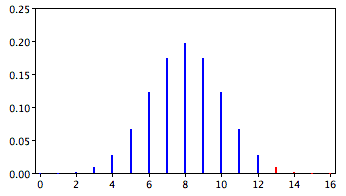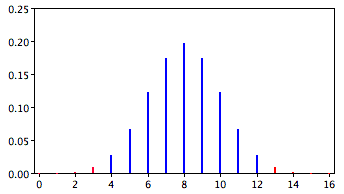One- and Two-Tailed Tests
Prerequisites
Questions
- When to use one-tailed and when two-tailed test?
One-tailed probability
- In the James Bond case study, Mr. Bond was given 16 trials on which he judged whether a martini had been shaken or stirred
- He was correct on 13 of the trials
- From the binomial distribution, we know that the probability of being correct 13 or more times out of 16 if one is only guessing is 0.0106
- The red bars show the values greater than or equal to 13
- As you can see in the figure, the probabilities are calculated for the upper tail of the distribution
- A probability calculated in only one tail of the distribution is called a one-tailed probability
Two-tailed probability
- A slightly different question can be asked of the data: "What is the probability of getting a result as extreme or more extreme than the one observed"?
- Since the chance expectation is 8/16, a result of 3/16 is equally as extreme as 13/16
- Thus, to calculate this probability, we would consider both tails of the distribution
- Since the binomial distribution is symmetric when π = 0.5, this probability is exactly double the probability of 0.0106 computed previously
- Therefore, p = 0.0212
- A probability calculated in both tails of a distribution is called a two-tailed probability
One-tailed vs Two-tailed
Should the one-tailed or the two-tailed probability be used to assess Mr. Bond's performance? That depends on the way the question is posed:
One-tailed
- Is Mr. Bond is better than chance at determining whether a Martini is shaken or stirred?
H0: π ≤ 0.5 H1: π ≥ 0.5 H0 rejected only if the sample proportion is much greater than 0.50.
What would the one-tailed probability be if Mr. Bond was correct on only three of the sixteen trials?
- Since the one-tailed probability is the probability of the right-hand tail, it would be the probability of getting three or more correct out of 16.
- This is a very high probability and the null hypothesis would not be rejected.
Two-tailed
- Can Mr. Bondn tell the difference between shaken or stirred martinis?
- We would conclude he could tell the difference if:
- he performed either much better than chance
- or much worse than chance
- If he performed much worse than chance, we would conclude that he can tell the difference, but he does not know which is which
- Therefore, since we are going to reject the null hypothesis if Mr. Bond does either very well or very poorly, we will use a two-tailed probability
H0: π = 0.5 H1: π ≠ 0.5 H0 rejected if the sample proportion correct deviates greatly from 0.5 in either direction
How to decide?
- You should always decide whether you are going to use a one-tailed or a two-tailed probability before looking at the data
- Tests that compute one-tailed probabilities are called one-tailed tests; those that compute two-tailed probabilities are called two-tailed tests
| One-tailed tests | Two-tailed tests |
|---|---|
| more common in scientific research because an outcome signifying that something other than chance is operating is usually worth noting | appropriate when it is not important to distinguish between no effect and an effect in the unexpected direction |
| Questions like: is A better than B | Questions like: is A has any effect on B |
Common Cold Treatment
- For example, consider an experiment designed to test the efficacy of treatment for the common cold
- The researcher would only be interested in whether the treatment was better than a placebo control.
- It would not be worth distinguishing between the case in which the treatment was worse than a placebo and the case in which it was the same because in both cases the drug would be worthless
- Even if the researcher predicts the direction of an effect, the two-tailed test might be more appropriate
- If the effect comes out strongly in the non-predicted direction, the researcher is not justified in concluding that the effect is not zero
- Since this is unrealistic, one-tailed tests are usually viewed skeptically if justified on this basis alone.
Questions
Template:Statistics Links < Type I and II Errors | Significant Results >


